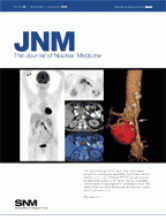TO THE EDITOR: Recently, Inglese et al. documented an extreme variability in the spatial and temporal heterogeneity of regional myocardial uptake on repeated whole-body 18F-FDG PET/CT in fasting oncologic patients without heart disease (1). The authors cautiously attributed uptake defects on myocardial 18F-FDG imaging to scar tissue, unless the defects are associated with severe hypoperfusion on 18F-FDG imaging used alone to evaluate myocardial viability. Furthermore, there are suggestions that 18F-FDG PET can detect radiation-induced myocardial damage early (e.g., in patients with esophageal cancer), but high myocardial 18F-FDG uptake corresponded to irradiated fields in only 20% of patients (2). In a case report, 18F-FDG PET/CT demonstrated an excellent concordance between increased myocardial 18F-FDG uptake and irradiated fields (3).
On the other hand, physiologic myocardial 18F-FDG uptake in fasting individuals free of any heart disease is controversial. Khandani et al. reported that a subjective visual determination of cardiac 18F-FDG uptake did not change significantly over time in 47 oncologic patients who underwent 4 to 9 serial PET scans (4). In contrast, de Groot et al. found that visual grading of myocardial 18F-FDG uptake changed significantly in nearly two thirds of 25 oncologic patients who underwent at least 3 serial PET scans (5).
We would like to report a 29-y-old man without evidence or a history of heart disease who showed an extremely high variability of global myocardial 18F-FDG uptake on 3 PET/CT scans. The patient was diagnosed with rhabdomyosarcoma of the right testis and underwent ablative surgery but still had multiple pulmonary and several lymphogenic metastases. The first 18F-FDG PET/CT scan was performed in October 2007 after 4 cycles of palliative chemotherapy and showed metastatic disease in the right and left lungs and inguinal lymph node involvement, but myocardial 18F-FDG uptake (maximal standardized uptake value [SUVmax], 2.7; mean [±SD] standardized uptake value [SUVmean], 1.6 ± 0.2) was comparable to the mediastinal background level. A second scan in January 2008 showed partial metabolic remission of these lung metastases after high-dose chemotherapy with carboplatin and etoposide followed by autologous stem cell transplantation in November 2007 but high global myocardial 18F-FDG uptake (SUVmax, 7.1; SUVmean, 4.5 ± 0.8). The patient had never received radiation treatment. Therefore, we did not observe radiation-related myocardial damage in the second PET/CT scan. Seven weeks later, in February 2008, the patient underwent the third PET/CT scan, which was performed because of suspected progressive disease under ongoing chemotherapy for consolidation but found metabolically (and morphologically) stable disease. The image showed myocardial 18F-FDG uptake comparable to the mediastinal background level of the first scan (SUVmax, 2.5; SUVmean, 1.5 ± 0.2). All routinely measured external parameters during the 3 scans were almost identical. The patient fasted at least 12 h before each examination. The blood glucose levels at the times of the first, second, and third scans were 6.0, 4.7, and 5.2 mmol/L, respectively, and the levels of creatinine (58 μmol/L at scan 1 and 54 μmol/L at scan 3) and TSH (1.85 mIU/L at scan 1 and 1.91 mIU/L at scan 3) were always within the reference range. The administered activities were 332, 313, and 317 MBq of 18F-FDG, and the scans started at 1 h 4 min, 59 min, and 59 min after injection. Of course, the reconstruction parameters for all images were identical. A 300% (!) increase in global myocardial 18F-FDG uptake occurred during the second scan.
It is still unclear to us why such an extremely high intraindividual variability in global myocardial 18F-FDG uptake can occur, but this variability underlines the necessity for further studies in this field. In this context, the set-up of Inglese et al. is only one side of the coin (1). The other side is to study modulation of glucose metabolism in myocytes for a better understanding of myocardial glucose metabolism (6), in particular after radiation treatment or stem cell transplantation (7).
Footnotes
-
COPYRIGHT © 2008 by the Society of Nuclear Medicine, Inc.







